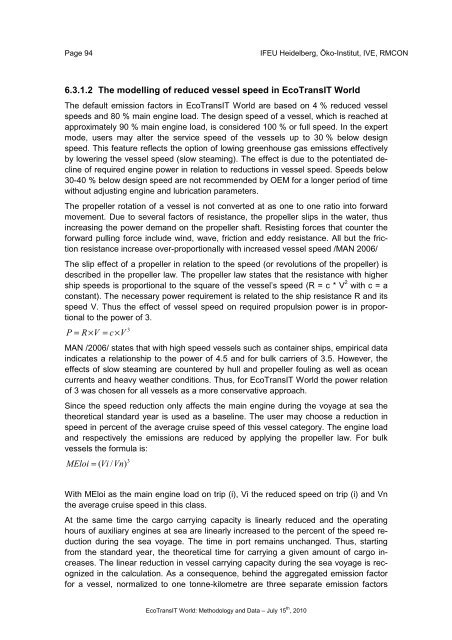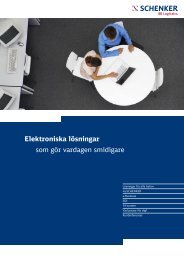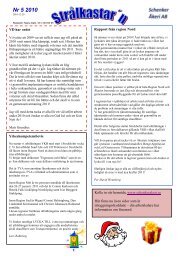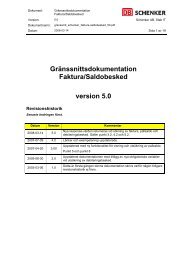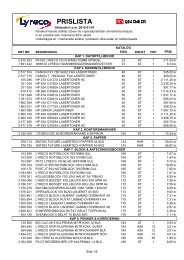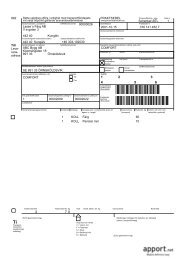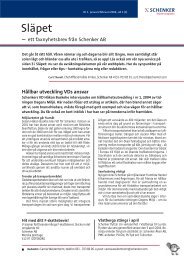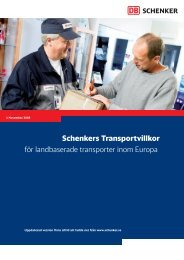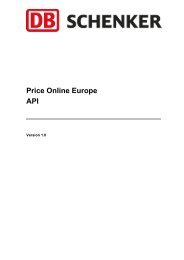Ecological Transport Information Tool for Worldwide ... - Schenker
Ecological Transport Information Tool for Worldwide ... - Schenker
Ecological Transport Information Tool for Worldwide ... - Schenker
Create successful ePaper yourself
Turn your PDF publications into a flip-book with our unique Google optimized e-Paper software.
Page 94<br />
IFEU Heidelberg, Öko-Institut, IVE, RMCON<br />
6.3.1.2 The modelling of reduced vessel speed in EcoTransIT World<br />
The default emission factors in EcoTransIT World are based on 4 % reduced vessel<br />
speeds and 80 % main engine load. The design speed of a vessel, which is reached at<br />
approximately 90 % main engine load, is considered 100 % or full speed. In the expert<br />
mode, users may alter the service speed of the vessels up to 30 % below design<br />
speed. This feature reflects the option of lowing greenhouse gas emissions effectively<br />
by lowering the vessel speed (slow steaming). The effect is due to the potentiated decline<br />
of required engine power in relation to reductions in vessel speed. Speeds below<br />
30-40 % below design speed are not recommended by OEM <strong>for</strong> a longer period of time<br />
without adjusting engine and lubrication parameters.<br />
The propeller rotation of a vessel is not converted at as one to one ratio into <strong>for</strong>ward<br />
movement. Due to several factors of resistance, the propeller slips in the water, thus<br />
increasing the power demand on the propeller shaft. Resisting <strong>for</strong>ces that counter the<br />
<strong>for</strong>ward pulling <strong>for</strong>ce include wind, wave, friction and eddy resistance. All but the friction<br />
resistance increase over-proportionally with increased vessel speed /MAN 2006/<br />
The slip effect of a propeller in relation to the speed (or revolutions of the propeller) is<br />
described in the propeller law. The propeller law states that the resistance with higher<br />
ship speeds is proportional to the square of the vessel’s speed (R = c * V 2 with c = a<br />
constant). The necessary power requirement is related to the ship resistance R and its<br />
speed V. Thus the effect of vessel speed on required propulsion power is in proportional<br />
to the power of 3.<br />
P = R × V = c×<br />
V<br />
3<br />
MAN /2006/ states that with high speed vessels such as container ships, empirical data<br />
indicates a relationship to the power of 4.5 and <strong>for</strong> bulk carriers of 3.5. However, the<br />
effects of slow steaming are countered by hull and propeller fouling as well as ocean<br />
currents and heavy weather conditions. Thus, <strong>for</strong> EcoTransIT World the power relation<br />
of 3 was chosen <strong>for</strong> all vessels as a more conservative approach.<br />
Since the speed reduction only affects the main engine during the voyage at sea the<br />
theoretical standard year is used as a baseline. The user may choose a reduction in<br />
speed in percent of the average cruise speed of this vessel category. The engine load<br />
and respectively the emissions are reduced by applying the propeller law. For bulk<br />
vessels the <strong>for</strong>mula is:<br />
MEloi = ( Vi / Vn)<br />
3<br />
With MEloi as the main engine load on trip (i), Vi the reduced speed on trip (i) and Vn<br />
the average cruise speed in this class.<br />
At the same time the cargo carrying capacity is linearly reduced and the operating<br />
hours of auxiliary engines at sea are linearly increased to the percent of the speed reduction<br />
during the sea voyage. The time in port remains unchanged. Thus, starting<br />
from the standard year, the theoretical time <strong>for</strong> carrying a given amount of cargo increases.<br />
The linear reduction in vessel carrying capacity during the sea voyage is recognized<br />
in the calculation. As a consequence, behind the aggregated emission factor<br />
<strong>for</strong> a vessel, normalized to one tonne-kilometre are three separate emission factors<br />
EcoTransIT World: Methodology and Data – July 15 th , 2010


